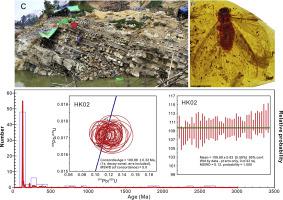当前位置:
X-MOL 学术
›
Palaeogeogr. Palaeoclimatol. Palaeoecol.
›
论文详情
Our official English website, www.x-mol.net, welcomes your
feedback! (Note: you will need to create a separate account there.)
Zircon U Pb age constraints on the mid-cretaceous Hkamti amber biota in northern Myanmar
Palaeogeography, Palaeoclimatology, Palaeoecology ( IF 2.6 ) Pub Date : 2020-11-01 , DOI: 10.1016/j.palaeo.2020.109960 Lida Xing , Liang Qiu
Palaeogeography, Palaeoclimatology, Palaeoecology ( IF 2.6 ) Pub Date : 2020-11-01 , DOI: 10.1016/j.palaeo.2020.109960 Lida Xing , Liang Qiu

|
Abstract Hkamti amber contains exquisite fossils, but the age of the amber biota is unclear. In this study, we documented the characteristics of fossils hosted in the amber, and we present zircon U Pb ages of tuff layers from the Kachin and Hkamti sites (i.e., the “new mine”). We also present a compilation of arthropod and echinoderm syn-inclusions from the mid-Cretaceous Hkamti amber of Myanmar, indicating a humid tropical or subtropical forest paleo-environment. Zircon analyses (n = 143) of four tuff samples that host the amber deposit in different pits yielded a weighted-mean age of 109.7 ± 0.4 Ma. Zircon rare earth element data demonstrate the zircons are of igneous origin. Therefore, the age of the Cretaceous amber biota from Hkamti is ca. 110 Ma. This means that the Hkamti assemblage should be treated as distinct from other Burmese amber collections, as it represents a significantly older source within a different depositional environment. The commercial sources of Burmese amber are variable and encompass multiple mining regions, which makes maintaining distinctions between deposits important if their faunal contents are to be studied in a proper temporal or ecological context. The refined understanding of amber deposits in Myanmar highlights the importance of distinguishing sources, but it also offers an opportunity to study a series of deposits from ~110 to ~72 Ma, instead of just one snapshot of terrestrial ecology around ~99 Ma.
中文翻译:

缅甸北部中白垩世 Hkamti 琥珀生物群的锆石 U Pb 年龄限制
摘要 Hkamti 琥珀含有精美的化石,但琥珀生物群的年龄尚不清楚。在这项研究中,我们记录了琥珀中化石的特征,并展示了克钦和哈卡姆提遗址(即“新矿”)凝灰岩层的锆石 U Pb 年龄。我们还提供了来自缅甸中白垩世 Hkamti 琥珀的节肢动物和棘皮动物同内含物的汇编,表明潮湿的热带或亚热带森林古环境。对不同矿坑中蕴藏琥珀矿床的四个凝灰岩样品进行的锆石分析 (n = 143) 得出的加权平均年龄为 109.7 ± 0.4 Ma。锆石稀土元素数据表明锆石为火成岩。因此,来自 Hkamti 的白垩纪琥珀生物群的年龄约为 110 马。这意味着 Hkamti 组合应与其他缅甸琥珀收藏区分开来对待,因为它代表了不同沉积环境中明显更古老的来源。缅甸琥珀的商业来源是可变的,包括多个矿区,如果要在适当的时间或生态背景下研究其动物群内容,那么保持矿床之间的区别很重要。对缅甸琥珀矿床的深入了解凸显了区分来源的重要性,但它也提供了研究从 ~110 到 ~72 Ma 的一系列沉积物的机会,而不仅仅是 ~99 Ma 左右的陆地生态快照。缅甸琥珀的商业来源是可变的,包括多个矿区,如果要在适当的时间或生态背景下研究其动物群内容,那么保持矿床之间的区别很重要。对缅甸琥珀矿床的深入了解凸显了区分来源的重要性,但它也提供了研究从 ~110 到 ~72 Ma 的一系列沉积物的机会,而不仅仅是 ~99 Ma 左右的陆地生态快照。缅甸琥珀的商业来源是可变的,包括多个矿区,如果要在适当的时间或生态背景下研究其动物群内容,那么保持矿床之间的区别很重要。对缅甸琥珀矿床的深入了解凸显了区分来源的重要性,但它也提供了研究从 ~110 到 ~72 Ma 的一系列沉积物的机会,而不仅仅是 ~99 Ma 左右的陆地生态快照。
更新日期:2020-11-01
中文翻译:

缅甸北部中白垩世 Hkamti 琥珀生物群的锆石 U Pb 年龄限制
摘要 Hkamti 琥珀含有精美的化石,但琥珀生物群的年龄尚不清楚。在这项研究中,我们记录了琥珀中化石的特征,并展示了克钦和哈卡姆提遗址(即“新矿”)凝灰岩层的锆石 U Pb 年龄。我们还提供了来自缅甸中白垩世 Hkamti 琥珀的节肢动物和棘皮动物同内含物的汇编,表明潮湿的热带或亚热带森林古环境。对不同矿坑中蕴藏琥珀矿床的四个凝灰岩样品进行的锆石分析 (n = 143) 得出的加权平均年龄为 109.7 ± 0.4 Ma。锆石稀土元素数据表明锆石为火成岩。因此,来自 Hkamti 的白垩纪琥珀生物群的年龄约为 110 马。这意味着 Hkamti 组合应与其他缅甸琥珀收藏区分开来对待,因为它代表了不同沉积环境中明显更古老的来源。缅甸琥珀的商业来源是可变的,包括多个矿区,如果要在适当的时间或生态背景下研究其动物群内容,那么保持矿床之间的区别很重要。对缅甸琥珀矿床的深入了解凸显了区分来源的重要性,但它也提供了研究从 ~110 到 ~72 Ma 的一系列沉积物的机会,而不仅仅是 ~99 Ma 左右的陆地生态快照。缅甸琥珀的商业来源是可变的,包括多个矿区,如果要在适当的时间或生态背景下研究其动物群内容,那么保持矿床之间的区别很重要。对缅甸琥珀矿床的深入了解凸显了区分来源的重要性,但它也提供了研究从 ~110 到 ~72 Ma 的一系列沉积物的机会,而不仅仅是 ~99 Ma 左右的陆地生态快照。缅甸琥珀的商业来源是可变的,包括多个矿区,如果要在适当的时间或生态背景下研究其动物群内容,那么保持矿床之间的区别很重要。对缅甸琥珀矿床的深入了解凸显了区分来源的重要性,但它也提供了研究从 ~110 到 ~72 Ma 的一系列沉积物的机会,而不仅仅是 ~99 Ma 左右的陆地生态快照。











































 京公网安备 11010802027423号
京公网安备 11010802027423号